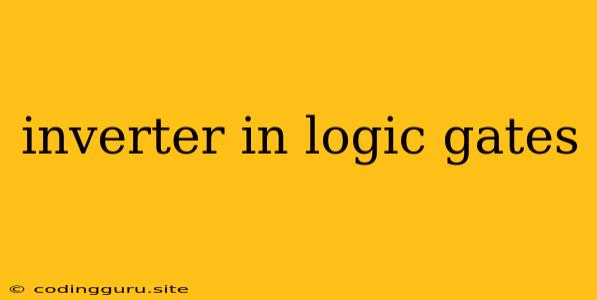What is an Inverter in Logic Gates?
An inverter is a fundamental building block in digital logic circuits. It's the simplest logic gate, performing a NOT operation. In essence, it flips the input signal, meaning a high (1) input produces a low (0) output, and vice versa.
Think of it like a light switch. If the switch is on (1), the light is off (0), and if the switch is off (0), the light is on (1). This inversion principle is crucial in building complex digital circuits.
How Does an Inverter Work?
Inverter circuits typically use transistors, which act as electronically controlled switches. There are two primary types of transistors used in inverter circuits:
-
NMOS Inverter: This uses an N-channel MOSFET (Metal-Oxide-Semiconductor Field-Effect Transistor). When a high voltage is applied to the gate, the transistor turns on, allowing current to flow through the channel, creating a low output.
-
PMOS Inverter: This uses a P-channel MOSFET. When a high voltage is applied to the gate, the transistor turns off, blocking the current flow, resulting in a high output.
Why Are Inverters Important?
-
Signal Inversion: As mentioned earlier, they are the most basic logic gate, enabling the flipping of signal states. This is crucial for numerous operations within digital circuits.
-
Creating Complementary Signals: Inverters can be used to create complementary signals, which are essential for many logic operations like NAND, NOR, and XOR gates.
-
Building Complex Circuits: Combining inverters with other logic gates (AND, OR, XOR) allows for the creation of complex logic circuits that perform specific tasks.
Applications of Inverters
-
Memory Circuits: Inverters are used in building memory cells, where they help store and retrieve data.
-
Clock Circuits: In timing circuits, inverters help generate clock signals that are crucial for synchronizing different parts of a digital system.
-
Data Transmission: Inverters are used in signal buffering to amplify weak signals or correct signal degradation during transmission.
Symbol and Truth Table
The symbol for an inverter is a triangle with a small circle at the output. This symbol represents the inversion of the input signal.
The truth table for an inverter clearly depicts its operation:
| Input (A) | Output (¬A) |
|---|---|
| 0 | 1 |
| 1 | 0 |
Example
Imagine a simple circuit with an input signal (A) and an output signal (¬A) connected by an inverter. If the input signal is HIGH (1), the output signal will be LOW (0). Conversely, if the input signal is LOW (0), the output signal will be HIGH (1).
Conclusion
Inverters are fundamental components of digital logic circuits. They are essential for signal inversion, creating complementary signals, and building complex logic circuits. Understanding their operation and applications is crucial for anyone working with digital electronics or designing logic systems.
